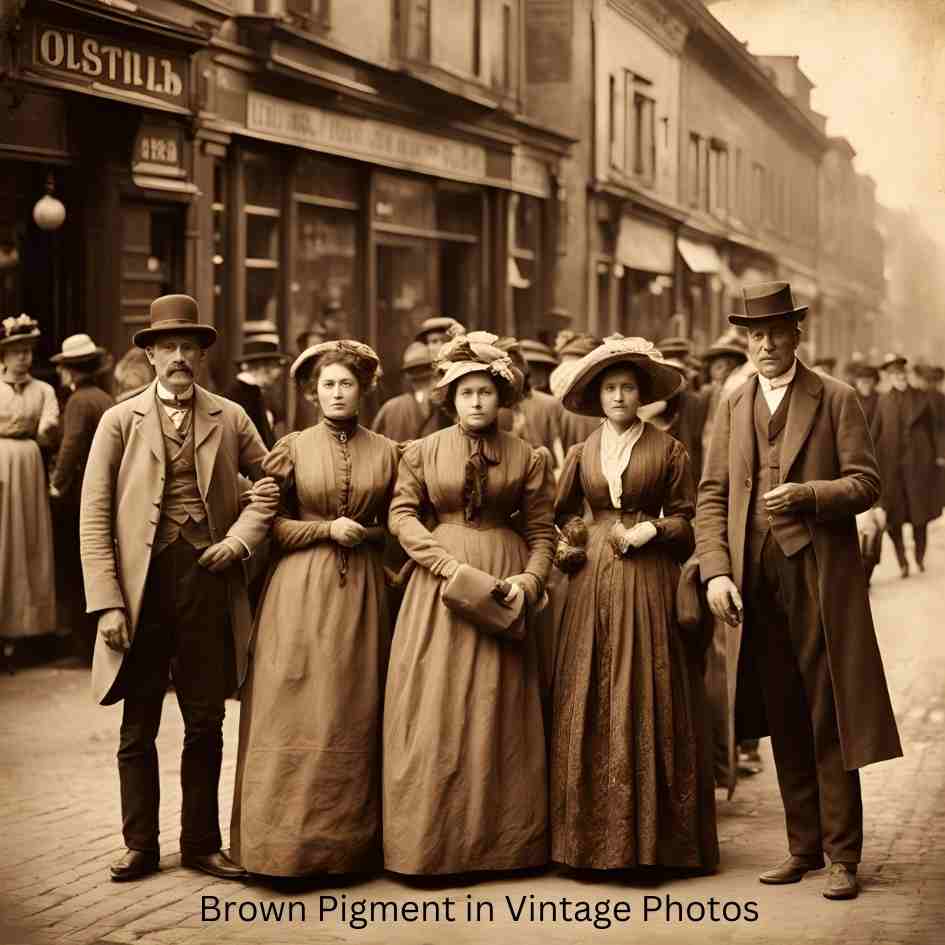Exploring Brown Pigment in Vintage Photos
Introduction
Brown pigment in vintage photos has played a pivotal role in shaping the aesthetics of early photography. The use of warm brown tones, often created through processes like sepia toning, not only added depth to images but also helped preserve them. This article will explore the chemical composition, historical significance, and modern applications of brown pigment in vintage photos.
Chemical Composition of Brown Pigments
The brown pigment in vintage photos is typically derived from natural sources such as iron oxide and sepia, produced from cuttlefish ink. These components provide the rich, warm tones characteristic of early photography.
Techniques for Producing Brown Pigment
In the 19th century, sepia toning was widely used to create brown hues in vintage photographs. Sepia toning involved treating black-and-white prints with chemicals to replace the metallic silver in the photo with sepia, producing the distinct brown pigment in vintage images.
Importance of Brown Pigment in Vintage Photography
The brown pigment in vintage photography served both an aesthetic and practical purpose. The rich brown tones added warmth and texture to the images, while the chemical properties of sepia helped protect the photos from degradation over time. This made it a popular choice for portrait and landscape photography.
Restoration of Vintage Photos with Brown Pigments
Restoring vintage photos that use brown pigment can be challenging but rewarding. Over time, these pigments may fade due to exposure to light and environmental factors. Restoration specialists often use digital tools to revive the warmth and clarity of these photos, ensuring that the original tones remain intact.
Future of Brown Pigment in Photography
Though modern photography tends to favor full color, vintage photos still show a strong appreciation for the brown pigment. Digital photography tools now allow for precise control of brown tones, helping modern photographers recreate the nostalgic feel of vintage images.
Using “Brown Pigment in Vintage Photos” naturally and strategically throughout the article makes the content highly relevant for search engines while maintaining a natural, informative tone for readers.
The Role of Sepia Toning in Brown Pigment
Sepia toning is the most well-known method for producing brown pigment in vintage photos. This process, originating in the mid-19th century, was used to give photographs a unique aesthetic and enhance their longevity. The sepia tones gave a warm, brown hue to black-and-white pictures, making them more visually appealing. The practice of sepia toning became synonymous with vintage photography, and today, many people still associate these brown pigments with old photos, even though the technique is used less frequently in modern times.
Preservation of Brown Pigmented Photos
Preserving the brown pigment in vintage photography requires careful attention to environmental factors. Light exposure is one of the primary causes of pigment fading, particularly in photos that use early sepia or other brown pigments. To prevent this, collectors and archivists often store such photographs in acid-free materials and avoid direct sunlight. The importance of proper storage cannot be overstated, as it helps maintain the integrity of the original brown pigment and prevents degradation over time.
Brown Pigment in Vintage Photos Across Different Cultures
While brown pigment in vintage photos is often associated with Western photography, it was used across many cultures. In Asian photography, for example, brown tones were used to evoke a sense of calmness and timelessness in portraits and landscapes. Meanwhile, in Western photography, the brown pigment was more commonly used to capture historical events, landscapes, and family portraits, adding depth and warmth to the images.
Collecting Vintage Photos with Brown Pigment
For collectors, the brown pigment in vintage photos represents a prized aesthetic and historical value. Identifying accurate vintage photos with natural brown tones involves examining the quality of the pigments, the paper used, and the age of the photograph. Collectors also look for signs of original sepia toning, which can distinguish an authentic vintage photo from a modern reproduction. Proper care and restoration techniques are vital to preserving the rich brown pigment in these valuable pieces of history.
The Artistic Appeal of Brown Pigment
Artists and photographers have long favored the brown pigment in vintage photos for its ability to evoke emotions and capture timeless beauty. The earthy tones of brown pigment add warmth, contrast, and a nostalgic feel that is difficult to replicate with modern color photography. Even today, many contemporary photographers use digital techniques to apply a sepia-like effect to their images, paying homage to the artistic legacy of brown-toned vintage photos.
Brown Pigment vs. Black and White Photography
A critical distinction between the brown pigment in vintage photography and traditional black-and-white photography is the emotional and visual depth that brown tones provide. While black-and-white photos emphasize stark contrasts, brown pigments add warmth and softness, making the images more inviting and emotionally charged. This is why brown pigments were often chosen for portrait photography, where capturing the warmth of human emotion was a priority.
Emotional Impact of Brown Pigment in Photos
The brown pigment in vintage photography often evokes nostalgia, warmth, and sentimentality. Brown tones can remind viewers of the past, creating a sense of history and personal connection to the image. Many vintage family portraits, for example, use brown pigments to capture intimate moments, drawing the viewer into the photograph in a way that stark black-and-white images may not.
Brown Pigment in Modern Photography
Although technology has advanced, many photographers continue to inspire their work with vintage photos’ brown pigment. Digital editing tools allow photographers to recreate sepia tones and other brown pigments, adding an old-world charm to contemporary images. This fusion of old and new techniques shows that the appeal of brown pigment endures, even in the age of digital photography.
Case Study: The Timelessness of Brown Pigment in Vintage Photography
One iconic example of brown pigment in vintage photos is the work of Edward S. Curtis, a photographer known for documenting Native American life in the early 20th century. His use of sepia tones and brown pigments not only preserved the authenticity of the images but also highlighted the warmth and humanity of his subjects. Curtis’s work is a testament to the power of brown pigments in capturing historical significance and emotional depth.
Conclusion
The brown pigment in vintage photos holds a unique place in the history of photography, offering both aesthetic and practical benefits. From sepia-toned portraits to modern digital reproductions, brown pigments add warmth, depth, and emotional resonance to images. As technology evolves, the legacy of these pigments continues to inspire photographers and collectors alike, ensuring that the rich tones of vintage photography remain a timeless part of the art form.
FAQs
What is the significance of brown pigment in vintage photos?
The brown pigment in vintage photos adds warmth, depth, and historical significance. It was used in sepia toning to enhance early photographs’ aesthetic appeal and longevity.
Why did photographers use brown pigments in the 19th century?
Photographers used brown pigment in vintage photos to create a warm, rich tone and to preserve the images. The chemical properties of sepia helped protect the photos from fading, making it a popular choice in early photography.
How can I preserve vintage photos with brown pigment?
To preserve vintage photos with brown pigment, store them in acid-free materials and keep them away from direct sunlight. Controlling humidity and temperature also helps prevent fading and degradation over time.
Is sepia the same as brown pigment in vintage photos?
Sepia is a brown pigment in vintage photos derived from cuttlefish ink. While sepia is one of photography’s most common brown pigments, other brown pigments may come from different chemical processes.
Can modern photographers use brown pigments in their work?
Modern photographers can replicate the brown pigment in vintage photos using digital tools. Editing software allows them to add sepia tones or other brown effects to create a vintage feel in contemporary photography.














Post Comment